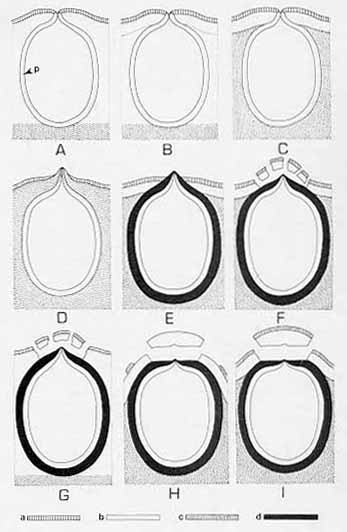









|
Ostioles have weighed heavily in the taxonomy at
subgeneric levels. Miller (1961) classified taxa with "umbilicate" ostioles in
section Hypoxylon, taxa with "papillate" ostioles in section Papillata,
and taxa with discs surrounding ostioles in section Annulata. However, it
should be emphasized that every taxon that we have studied essentially has papillate
ostioles. In section Hypoxylon, the umbilicate feature in most taxa is
actually caused by loss of stromatal tissue directly above the papillate ostioles which
come to be lower than the stromatal surface (Figs. 1A, 1B, & 1C). Therefore, we prefer
to describe ostioles as being higher or lower than the stromatal surface instead of being
"umbilicate" or "papillate". Levels of ostioles relative to stromatal
surfaces are useful in determining whether a fungus belongs to section Hypoxylon
or section Annulata.
Only a few taxa in section Hypoxylon have ostioles higher than the stromatal
surface, but virtually every member of section Annulata has ostioles higher
than the stromatal surface. The ostiolar disc is one of the hallmarks of section Annulata
(Figs. 1F-1I and also see truncatum-type
and
bovei-type
ostiolar disc formations); it is found exclusively in this section. Figure 1. A-I.
Vertical sections of stromata in various Hypoxylon showing the distributions
of different stromatal tissues. A. H. rubiginosum. B.
H. fragiforme. C. H. placentiforme.
D. H. monticulosum. E. H. multiforme.
F. H. annulatum. G. H. stygium.
H. H. nitens. I. H. bovei.
a: outermost stromatal layer; b: waxy stromatal tissue; c: woody
stromatal tissue; d: carbonaceous stromatal tissue; p: perithecial wall.

|



